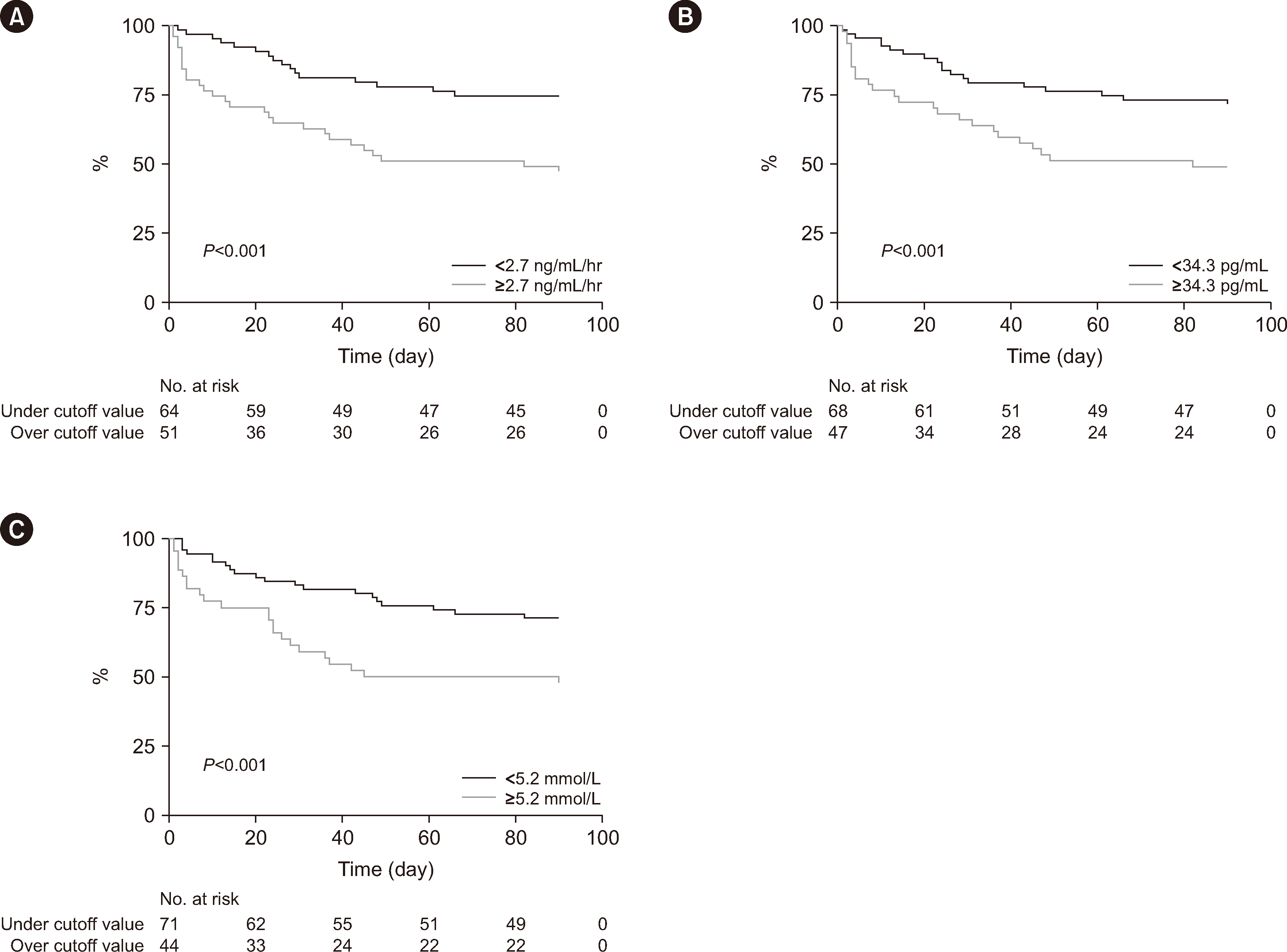1. Elbers PW, Ince C. 2006; Mechanisms of critical illness-classifying microcirculatory flow abnormalities in distributive shock. Crit Care. 10:221. DOI:
10.1186/cc4969. PMID:
16879732. PMCID:
PMC1750971.
2. Fleischmann C, Scherag A, Adhikari NK, Hartog CS, Tsaganos T, Schlattmann P, et al. 2016; Assessment of global incidence and mortality of hospital-treated sepsis. Current estimates and limitations. Am J Respir Crit Care Med. 193:259–72. DOI:
10.1164/rccm.201504-0781OC. PMID:
26414292.
6. Evans L, Rhodes A, Alhazzani W, Antonelli M, Coopersmith CM, French C, et al. 2021; Surviving sepsis campaign: international guidelines for management of sepsis and septic shock 2021. Crit Care Med. 49:e1063–143. DOI:
10.1097/CCM.0000000000005337. PMID:
34605781.
7. Singer M, Deutschman CS, Seymour CW, Shankar-Hari M, Annane D, Bauer M, et al. 2016; The third international consensus definitions for sepsis and septic shock (Sepsis-3). JAMA. 315:801–10. DOI:
10.1001/jama.2016.0287. PMID:
26903338. PMCID:
PMC4968574.
8. Gu WJ, Zhang Z, Bakker J. 2015; Early lactate clearance-guided therapy in patients with sepsis: a meta-analysis with trial sequential analysis of randomized controlled trials. Intensive Care Med. 41:1862–3. DOI:
10.1007/s00134-015-3955-2. PMID:
26154408.
9. Simpson SQ, Gaines M, Hussein Y, Badgett RG. 2016; Early goal-directed therapy for severe sepsis and septic shock: a living systematic review. J Crit Care. 36:43–8. DOI:
10.1016/j.jcrc.2016.06.017. PMID:
27546746.
10. Gómez-Ramos JJ, Marín-Medina A, Prieto-Miranda SE, Dávalos-Rodríguez IP, Alatorre-Jiménez MA, Esteban-Zubero E. 2018; Determination of plasma lactate in the emergency department for the early detection of tissue hypoperfusion in septic patients. Am J Emerg Med. 36:1418–22. DOI:
10.1016/j.ajem.2017.12.068. PMID:
29291989.
12. Casserly B, Phillips GS, Schorr C, Dellinger RP, Townsend SR, Osborn TM, et al. 2015; Lactate measurements in sepsis-induced tissue hypoperfusion: results from the Surviving Sepsis Campaign database. Crit Care Med. 43:567–73. DOI:
10.1097/CCM.0000000000000742. PMID:
25479113.
18. Bellomo R, Forni LG, Busse LW, McCurdy MT, Ham KR, Boldt DW, et al. 2020; Renin and survival in patients given angiotensin II for catecholamine-resistant vasodilatory shock. A clinical trial. Am J Respir Crit Care Med. 202:1253–61. DOI:
10.1164/rccm.201911-2172OC. PMID:
32609011. PMCID:
PMC7605187.
19. Gleeson PJ, Crippa IA, Mongkolpun W, Cavicchi FZ, Van Meerhaeghe T, Brimioulle S, et al. 2019; Renin as a marker of tissue-perfusion and prognosis in critically ill patients. Crit Care Med. 47:152–8. DOI:
10.1097/CCM.0000000000003544. PMID:
30653055.
20. Campbell DJ, Nussberger J, Stowasser M, Danser AH, Morganti A, Frandsen E, et al. 2009; Activity assays and immunoassays for plasma renin and prorenin: information provided and precautions necessary for accurate measurement. Clin Chem. 55:867–77. DOI:
10.1373/clinchem.2008.118000. PMID:
19264850.
21. Nguyen M, Denimal D, Dargent A, Guinot PG, Duvillard L, Quenot JP, et al. 2019; Plasma renin concentration is associated with hemodynamic deficiency and adverse renal outcome in septic shock. Shock. 52:e22–30. DOI:
10.1097/SHK.0000000000001285. PMID:
30407370.
23. Park H, Shin TG, Kim WY, Jo YH, Hwang YJ, Choi SH, et al. 2022; A quick Sequential Organ Failure Assessment-negative result at triage is associated with low compliance with sepsis bundles: a retrospective analysis of a multicenter prospective registry. Clin Exp Emerg Med. 9:84–92. DOI:
10.15441/ceem.22.230. PMID:
35843608. PMCID:
PMC9288871. PMID:
fce8323a50a3480abd838598d0ee6a85.
26. Khwaja A. 2012; KDIGO clinical practice guidelines for acute kidney injury. Nephron Clin Pract. 120:c179–84. DOI:
10.1159/000339789. PMID:
22890468.
27. Závada J, Hoste E, Cartin-Ceba R, Calzavacca P, Gajic O, Clermont G, et al. 2010; A comparison of three methods to estimate baseline creatinine for RIFLE classification. Nephrol Dial Transplant. 25:3911–8. DOI:
10.1093/ndt/gfp766. PMID:
20100732.
28. Jentzer JC, Vallabhajosyula S, Khanna AK, Chawla LS, Busse LW, Kashani KB. 2018; Management of refractory vasodilatory shock. Chest. 154:416–26. DOI:
10.1016/j.chest.2017.12.021. PMID:
29329694.
29. Lee GT, Hwang SY, Park JE, Jo IJ, Kim WY, Chung SP, et al. 2021; Diagnostic accuracy of lactate levels after initial fluid resuscitation as a predictor for 28 day mortality in septic shock. Am J Emerg Med. 46:392–7. DOI:
10.1016/j.ajem.2020.10.020. PMID:
33092937.
30. Jeyaraju M, McCurdy MT, Levine AR, Devarajan P, Mazzeffi MA, Mullins KE, et al. 2022; Renin kinetics are superior to lactate kinetics for predicting in-hospital mortality in hypotensive critically ill patients. Crit Care Med. 50:50–60. DOI:
10.1097/CCM.0000000000005143. PMID:
34166293.
31. Doerschug KC, Delsing AS, Schmidt GA, Ashare A. 2010; Renin-angiotensin system activation correlates with microvascular dysfunction in a prospective cohort study of clinical sepsis. Crit Care. 14:R24. DOI:
10.1186/cc8887. PMID:
20175923. PMCID:
PMC2875539.
32. Khanna A, English SW, Wang XS, Ham K, Tumlin J, Szerlip H, et al. 2017; Angiotensin II for the Treatment of Vasodilatory Shock. N Engl J Med. 377:419–30. DOI:
10.1056/NEJMoa1704154. PMID:
28528561.
33. Puskarich MA, Trzeciak S, Shapiro NI, Albers AB, Heffner AC, Kline JA, et al. 2013; Whole blood lactate kinetics in patients undergoing quantitative resuscitation for severe sepsis and septic shock. Chest. 143:1548–53. DOI:
10.1378/chest.12-0878. PMID:
23740148. PMCID:
PMC3673659.
34. Kang YR, Um SW, Koh WJ, Suh GY, Chung MP, Kim H, et al. 2011; Initial lactate level and mortality in septic shock patients with hepatic dysfunction. Anaesth Intensive Care. 39:862–7. DOI:
10.1177/0310057X1103900510. PMID:
21970130.
35. Ha TS, Shin TG, Jo IJ, Hwang SY, Chung CR, Suh GY, et al. 2016; Lactate clearance and mortality in septic patients with hepatic dysfunction. Am J Emerg Med. 34:1011–5. DOI:
10.1016/j.ajem.2016.02.053. PMID:
26976769.
39. Macdonald SPJ, Bosio E, Neil C, Arendts G, Burrows S, Smart L, et al. 2017; Resistin and NGAL are associated with inflammatory response, endothelial activation and clinical outcomes in sepsis. Inflamm Res. 66:611–9. DOI:
10.1007/s00011-017-1043-5. PMID:
28424824.
40. Zhang A, Cai Y, Wang PF, Qu JN, Luo ZC, Chen XD, et al. 2016; Diagnosis and prognosis of neutrophil gelatinase-associated lipocalin for acute kidney injury with sepsis: a systematic review and meta-analysis. Crit Care. 20:41. DOI:
10.1186/s13054-016-1212-x. PMID:
26880194. PMCID:
PMC4754917.






 PDF
PDF Citation
Citation Print
Print



 XML Download
XML Download